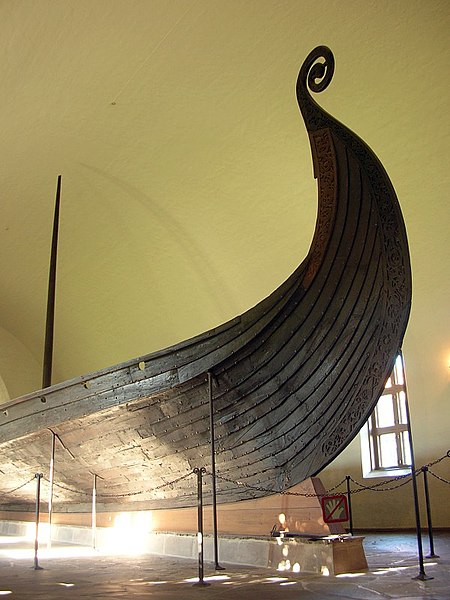HCA's chair Robin Wood visits Norway...
In 1903 a Norwegian farmer dug into a mound in one of his fields and
made a discovery which archaeologists rate as comparable in importance
to the grave of Tutankhamun.
The Oseberg farm is 60 miles south of Oslo outside the town of Tonsberg
and
for years Oscar Rom had wondered what lay under the mound in his field,
people said it was haunted and that it contained graves from the black
death. Soon after he started digging he came across some highly carved
wood and contacted archaeologists. The whole mound was excavated in
1905/5 revealing the earliest, the most complete and most beautiful
Viking ship to
survive. The burial mound contained many high status grave goods and the
bodies of two women all of which shed much light on Viking life but
for now I want to concentrate on the ship itself.

The ship was preserved and is displayed in the wonderful Viking Ship Museum at Oslo.
On June17th 2010 a new era in the exciting history of this ship began with a project to build an exact replica using the same tools and techniques as were used to build the original. As soon as I heard about the project I knew I had to visit and hopefully work on the ship. An internet friend Tim Allen had been volunteering on the worksite and put me in contact with the New Oseberg Ship Foundation arrangements were made and last week I spent 4 days working on this most remarkable of building sites. My camera cards are bursting with pictures so I'll do a few posts starting with the raw material.
The ship is built entirely of cleft and hewn oak, no saws were used. The trees by modern standards were impressive fat tall and straight grained, a foresters or saw-millers dream. Here are a couple of typical trees for the project with the part built ship in the background. Trees of this quality have proved impossible to source in Norway so most of the planking trees have come from Denmark. The oak for the keel, the backbone of the ship was however felled locally.
This is Thomas
Finderup who built the 4 large replica viking ships at the famous
Roskilde viking ship museum in Denmark. Nobody alive knows more about
Viking shipbuilding or tools.
And once they are happy they let visitors who's skill level they are not yet sure about have a go :0)
This split started to run off on the underside so we started again from the far end, this time it ran true. It was worth taking the time as the original tree was nearly £1000 and would yield just 16 of the widest planks.
once the split is going well you can use a bit more force, Tim with the big mell.
The thick wedge this produces is then hewn down to a single plank with a axe, planed, steamed, fitted and finally riveted into place with iron boat nails. More on that in the following posts. I'll also post about the organisation and running of the project and the gorgeous replica axes and other tools. Cleaving timber for ships like this died out, Thomas told me, in the 1200s, we can clearly see that the timbers of earlier ships were cleft and later they were sawn but the art of cleaving wide long boards for shipbuilding was completely lost for 800 years. Thomas and the team from Roskilde developed their way of working but no-one really knows exactly how the Vikings did it.












Fascinating. Thank you for blogging this.
ReplyDeleteWe saw some of the boats at the Roskilde museum, and some videos of the splitting and hewing. Interestingly the they seemed to stop and sharpen (just a tickle) their axes every few strokes or so, whether they were just maintaining an edge or removing a dink, I don't know. It didn't seem to interrupt he rhythm but became part of it. Expensive way of making a boat these days.
ReplyDelete